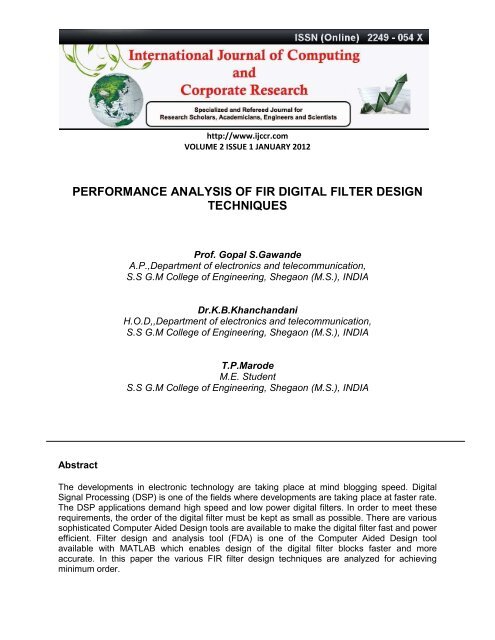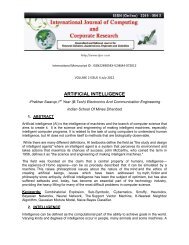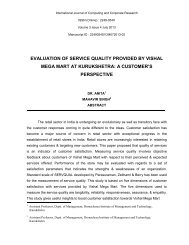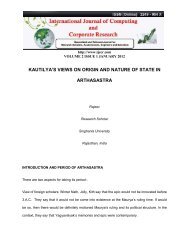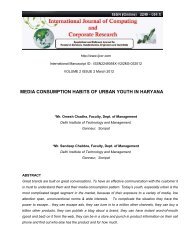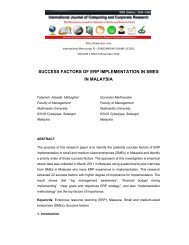performance analysis of fir digital filter design techniques - Ijccr.com
performance analysis of fir digital filter design techniques - Ijccr.com
performance analysis of fir digital filter design techniques - Ijccr.com
You also want an ePaper? Increase the reach of your titles
YUMPU automatically turns print PDFs into web optimized ePapers that Google loves.
http://www.ijccr.<strong>com</strong><br />
VOLUME 2 ISSUE 1 JANUARY 2012<br />
PERFORMANCE ANALYSIS OF FIR DIGITAL FILTER DESIGN<br />
TECHNIQUES<br />
Pr<strong>of</strong>. Gopal S.Gawande<br />
A.P.,Department <strong>of</strong> electronics and tele<strong>com</strong>munication,<br />
S.S G.M College <strong>of</strong> Engineering, Shegaon (M.S.), INDIA<br />
Dr.K.B.Khanchandani<br />
H.O.D,,Department <strong>of</strong> electronics and tele<strong>com</strong>munication,<br />
S.S G.M College <strong>of</strong> Engineering, Shegaon (M.S.), INDIA<br />
T.P.Marode<br />
M.E. Student<br />
S.S G.M College <strong>of</strong> Engineering, Shegaon (M.S.), INDIA<br />
Abstract<br />
The developments in electronic technology are taking place at mind blogging speed. Digital<br />
Signal Processing (DSP) is one <strong>of</strong> the fields where developments are taking place at faster rate.<br />
The DSP applications demand high speed and low power <strong>digital</strong> <strong>filter</strong>s. In order to meet these<br />
requirements, the order <strong>of</strong> the <strong>digital</strong> <strong>filter</strong> must be kept as small as possible. There are various<br />
sophisticated Computer Aided Design tools are available to make the <strong>digital</strong> <strong>filter</strong> fast and power<br />
efficient. Filter <strong>design</strong> and <strong>analysis</strong> tool (FDA) is one <strong>of</strong> the Computer Aided Design tool<br />
available with MATLAB which enables <strong>design</strong> <strong>of</strong> the <strong>digital</strong> <strong>filter</strong> blocks faster and more<br />
accurate. In this paper the various FIR <strong>filter</strong> <strong>design</strong> <strong>techniques</strong> are analyzed for achieving<br />
minimum order.
http://www.ijccr.<strong>com</strong><br />
VOLUME 2 ISSUE 1 JANUARY 2012<br />
Key words Blackman window, Digital <strong>filter</strong>, Equiripple <strong>filter</strong>, FIR <strong>filter</strong>, FDA tool, Kaiser<br />
Window, low pass <strong>filter</strong>, Optimal <strong>filter</strong> <strong>design</strong>.<br />
I. Introduction<br />
The developments in electronic technology are taking place at a tremendous speed.<br />
Recently, Digital Signal Processing (DSP) is used in numerous applications such as video<br />
<strong>com</strong>pression, <strong>digital</strong> set-top box, cable modems, <strong>digital</strong> versatile disk, portable video<br />
systems/<strong>com</strong>puters, <strong>digital</strong> audio, multimedia and wireless <strong>com</strong>munications, <strong>digital</strong> radio, <strong>digital</strong><br />
still and network cameras, speech processing, transmission systems, radar imaging, acoustic<br />
beam formers, global positioning systems, and biomedical signal processing. The field <strong>of</strong> DSP<br />
has always been driven by the advances in DSP applications and in scaled Very-Large-Scale-<br />
Integrated (VLSI) technologies.<br />
Digital <strong>filter</strong>s are important class <strong>of</strong> Linear Time Invariant (LTI) DSP systems <strong>design</strong>ed to<br />
modify the frequency characteristics <strong>of</strong> the input signal x(n) to meet certain specific <strong>design</strong><br />
requirements. Digital <strong>filter</strong>s are widely used because <strong>of</strong> certain advantages over Analog <strong>filter</strong>s.<br />
Digital <strong>filter</strong>s have the potential to attain much better signal to noise ratios than Analog <strong>filter</strong>s.<br />
Digital Filters have emerged as a strong option for removing noise, shaping spectrum and<br />
minimizing inter-symbol interference (ISI) in <strong>com</strong>munication architectures.[1]<br />
Digital <strong>filter</strong>s can be classified into Finite Impulse Response (FIR) and Infinite Impulse<br />
Response (IIR) <strong>filter</strong>s. The selection <strong>of</strong> FIR or IIR <strong>digital</strong> <strong>filter</strong> depends on the nature <strong>of</strong> the<br />
problem and specifications <strong>of</strong> the desired frequency response. In <strong>design</strong>ing <strong>digital</strong> <strong>filter</strong>s, it is<br />
usually desirable to have approximately flat frequency response, magnitude in pass band.<br />
Another important desirable feature <strong>of</strong> <strong>digital</strong> <strong>filter</strong> is <strong>of</strong> linear phase. A linear phase with integer<br />
slope corresponds to a simple delay in the time domain, and it reduces the phase distortion to a<br />
minimum in the frequency domain. The FIR <strong>filter</strong> <strong>of</strong> length M is described by the convolution <strong>of</strong><br />
unit sample response h(n) <strong>of</strong> the system with input signal x(n) and is represented by the<br />
equation 1.[6]<br />
yn= <br />
M-1<br />
k=0<br />
hk.xn-k<br />
equation. 1<br />
Thus impulse response <strong>of</strong> the <strong>filter</strong> denotes the coefficient <strong>of</strong> FIR <strong>filter</strong>.<br />
FIR <strong>filter</strong>s specification include the maximum tolerable pass band ripple, maximum tolerable<br />
stop band ripple, pass band edge frequency and stop band edge frequency.<br />
Calculating coefficients <strong>of</strong> FIR <strong>filter</strong> requires considerable amount <strong>of</strong> <strong>com</strong>putations.<br />
Therefore it is generally performed by using various Computer Aided Design tools such as Filter<br />
<strong>design</strong> and <strong>analysis</strong> (FDA) tool <strong>of</strong> MATLAB.
http://www.ijccr.<strong>com</strong><br />
VOLUME 2 ISSUE 1 JANUARY 2012<br />
II. FIR <strong>filter</strong> Design Techniques<br />
FIR <strong>filter</strong> <strong>design</strong> essentially consist <strong>of</strong> two parts:<br />
i. Approximation problem<br />
ii. Realization problem.<br />
The approximation stage takes the specification and gives transfer function.<br />
Realization part deals with choosing the structure to implement the transfer function which may<br />
be in the form <strong>of</strong> circuit diagram or in the form <strong>of</strong> a program [3].<br />
There are various methods to <strong>design</strong> FIR <strong>filter</strong> as follows:<br />
I. Window technique.<br />
II. Optimal <strong>filter</strong> <strong>design</strong> methods.<br />
The windowing <strong>design</strong> technique is simple and convenient but not optimal i.e. order<br />
achieving is not minimum possible. Some <strong>of</strong> the windows <strong>com</strong>monly used are Blackman,<br />
Blackman-harris, Kaiser, Bohman, Chebyshew, Flat top, Gaussian, Hamming, Hann, Parzen,<br />
Rectangular, etc.<br />
In frequency sampling technique for FIR <strong>filter</strong> <strong>design</strong> we specify the desired frequency<br />
response H d (w) at a set <strong>of</strong> equally spaced frequencies at N samples. This method is useful for<br />
the <strong>design</strong> <strong>of</strong> non prototype <strong>filter</strong>s where the desired magnitude response can take any irregular<br />
shape.<br />
The various optimal <strong>filter</strong> <strong>design</strong> methods are Least square, Equiripple, Maximally flat,<br />
Generalized equripple, Constrained band equiripple,etc. The basic idea in each method is to<br />
<strong>design</strong> the <strong>filter</strong> coefficients again and again until particular error is minimum [3].<br />
III. Designing <strong>digital</strong> Filter using FDATool<br />
The Filter Design and Analysis Tool (FDATool) is a powerful Graphical user interface<br />
(GUI) for <strong>design</strong>ing and analyzing <strong>filter</strong>s quickly. FDATool enables you to <strong>design</strong> <strong>digital</strong> FIR or<br />
IIR <strong>filter</strong>s by setting <strong>filter</strong> specifications, by importing <strong>filter</strong>s from your MATLAB workspace, or by<br />
adding, moving or deleting poles and zeros. FDATool also provides tools for analyzing <strong>filter</strong>s,<br />
such as magnitude and phase response and pole-zero plots. FDATool seamlessly integrates<br />
additional functionality from other MathWorks products.<br />
The specifications <strong>of</strong> FIR low pass <strong>filter</strong> are in given in table 1.<br />
Table 1: FIR <strong>filter</strong> specifications.
http://www.ijccr.<strong>com</strong><br />
VOLUME 2 ISSUE 1 JANUARY 2012<br />
Filter <strong>performance</strong> parameter<br />
Pass band frequency<br />
Pass band attenuation(δp)<br />
Stop band frequency<br />
Stop band attenuation(δs)<br />
Sampling frequency<br />
Value<br />
10000 Hz<br />
3 dB<br />
11000 Hz<br />
60 dB<br />
44000 Hz<br />
In this paper, the various FIR <strong>filter</strong> <strong>design</strong> <strong>techniques</strong> are used to meet the specifications<br />
given in table 1 using FDA tool. The results <strong>of</strong> these FIR <strong>filter</strong> <strong>design</strong> <strong>techniques</strong> are then<br />
<strong>com</strong>pared for minimal order.<br />
IV. Window Technique for <strong>digital</strong> FIR <strong>filter</strong> <strong>design</strong><br />
The simplest technique used to develop <strong>digital</strong> FIR <strong>filter</strong>s is windowed <strong>filter</strong>s. This<br />
technique is based on <strong>design</strong>ing a <strong>filter</strong> using well-known frequency-domain transition functions<br />
called windows. The use <strong>of</strong> windows <strong>of</strong>ten involves choosing the lesser <strong>of</strong> two evils. Some<br />
windows, such as the rectangular, yield fast roll <strong>of</strong>f in the frequency domain but have limited<br />
attenuation in the stop band along with poor group delay characteristics. Other windows, like the<br />
Blackman, have better stop-band attenuation and group delay but a wide transition band.<br />
Windowed <strong>filter</strong>s are easy to use and scalable and can be <strong>com</strong>puted on the fly by the DSP. This<br />
latter point means that a tunable <strong>filter</strong> can be <strong>design</strong>ed with the only limitation on corner<br />
frequency resolution being the number <strong>of</strong> bits in the tuning word.[3]<br />
In Window method, [4-6] from the desired frequency response specification H d ,<br />
corresponding unit sample response H d (n) is determined using the following relation.<br />
H d (n) = <br />
<br />
<br />
<br />
<br />
∞<br />
where H d = h <br />
∞<br />
equation 2<br />
equation 3<br />
Various types <strong>of</strong> windows can be used to meet the specifications given in table 1 and<br />
their relative <strong>performance</strong> is shown in table 2. While <strong>design</strong>ing <strong>digital</strong> <strong>filter</strong>, order <strong>of</strong> <strong>filter</strong> (N) is<br />
always a matter <strong>of</strong> concern. In this paper, the <strong>performance</strong> <strong>of</strong> various FIR <strong>filter</strong> <strong>design</strong> methods<br />
is measured in terms <strong>of</strong> order required to implement <strong>digital</strong> <strong>filter</strong>.
http://www.ijccr.<strong>com</strong><br />
VOLUME 2 ISSUE 1 JANUARY 2012<br />
Table 2. : Performance <strong>com</strong>parision <strong>of</strong> various windows for FIR <strong>filter</strong> <strong>design</strong><br />
Sr. No. Type <strong>of</strong> Window Passband<br />
attenuation(δp)<br />
Sopband<br />
attenuation(δs)<br />
Order <strong>of</strong><br />
Window(N)<br />
1 Blackman 2.492 dB 60.09026 dB 550<br />
2 Blackman-Harris 2.5034 dB 64.62253 dB 700<br />
3 Bohman 0.0001393 dB 60.1558 dB 900<br />
4 Chebyshew 1.5769 dB 81.00921 dB 750<br />
5 Flat top 1.1159 dB 109.3473 dB 1100<br />
6 Gaussian 0.00222 dB 68.319 dB 850<br />
7 Hamming 0.0016 dB 64.10399 dB 1250<br />
8 Hann 0.0001880 dB 62.136 dB 800<br />
9 Nutall 1.66671 dB 65.63894 dB 700<br />
10 Parzen 2.2890 dB 73.64271 dB 1900<br />
11 Rectangular 0.0006728 dB 66.4774 dB 1800<br />
12 Kaiser 0.04369 60.21 dB 160<br />
The Hanning, Hamming and Blackman windows use progressively more <strong>com</strong>plicated cosine<br />
functions to provide a smooth truncation <strong>of</strong> the ideal impulse response and a frequency<br />
response that looks better. But the best window results probably <strong>com</strong>e from using the Kaiser<br />
window, which allows adjustment <strong>of</strong> the <strong>com</strong>promise between the overshoot reduction and<br />
transition region width spreading as shown in figure 1.
http://www.ijccr.<strong>com</strong><br />
VOLUME 2 ISSUE 1 JANUARY 2012<br />
Figure 1. : Magnitude response (dB) for Kaiser window.<br />
Another window that closely approximates the desired frequency characteristics feed is<br />
Blackman window whose magnitude response is shown in figure 2.
http://www.ijccr.<strong>com</strong><br />
VOLUME 2 ISSUE 1 JANUARY 2012<br />
Figure 2 : Magnitude response (dB) for Blackman window.<br />
V. Optimal Filter Design Methods for <strong>digital</strong> FIR <strong>filter</strong> <strong>design</strong><br />
In Optimal Filter Design Method various methods are used to <strong>design</strong> the <strong>filter</strong><br />
coefficients again and again until a particular error is minimized. The various methods are as<br />
follows:<br />
i. Least square method.<br />
ii. Equiripple method.<br />
iii. Maximally flat.<br />
iv. Generalised equiripple.<br />
v. Constrained band equiripple.<br />
In Least square method there is no constraint on the response between the sample<br />
points, and poor results may be obtained. The frequency sampling technique is more <strong>of</strong> an
http://www.ijccr.<strong>com</strong><br />
VOLUME 2 ISSUE 1 JANUARY 2012<br />
interpolation method rather than an approximation method. Least square method [6-7] controls<br />
the response between the sample points by considering a number <strong>of</strong> sample points larger than<br />
the order <strong>of</strong> the <strong>filter</strong>. As the energy <strong>of</strong> the signal is related to the square <strong>of</strong> the signal, a squared<br />
error approximation criterion is appropriate to optimize the <strong>design</strong> <strong>of</strong> the FIR <strong>filter</strong>s.<br />
The Remez/Parks McLellan method produces a <strong>filter</strong> which just meets the specification<br />
without overperforming. Many <strong>of</strong> the window method <strong>design</strong>s actually perform better as you<br />
move further away from the passband, and means they are using more <strong>filter</strong> coefficients than<br />
they need. This means that they are using more <strong>filter</strong> coefficients than they need.<br />
To <strong>design</strong> equiripple linear-phase FIR <strong>filter</strong>s with linear constraint method is carried out<br />
by using the Remez exchanges algorithm. A technique is derived to convert a linearly<br />
constrained problem to an equivalent unconstrained one. The key step is to modify the original<br />
desired frequency response such that the constraint is reduced to a null constraint for the new<br />
target frequency response. Then the <strong>filter</strong> constrained by such constraint can be <strong>design</strong>ed<br />
without any constraint by a set <strong>of</strong> bases obtained by transforming the original basis by the null<br />
space. [8]<br />
Equiripple <strong>design</strong> produces most efficient <strong>filter</strong> with minimum possible order.<br />
Table 3 Optimal Filter Methods for <strong>digital</strong> FIR <strong>filter</strong> <strong>design</strong><br />
Sr. No. FIR <strong>filter</strong> <strong>design</strong> Passband Sopband Order <strong>of</strong><br />
Technique attenuation(δp) attenuation(δs) Window(N)<br />
1 Eqiripple 1.91601 dB 60.9234 dB 71<br />
2 Least square 0.01939 dB 60.45124 dB 185<br />
3 Maximally flat 1.2554 dB 4.56 dB 110<br />
4 Generalized<br />
eqiripple<br />
5 Constrained<br />
band equiripple<br />
2.63329 dB 60.496 dB 75<br />
0.08426 dB 60.6305 dB 145<br />
VI.<br />
Conclusion
http://www.ijccr.<strong>com</strong><br />
VOLUME 2 ISSUE 1 JANUARY 2012<br />
The paper briefly describes the various technique used to <strong>design</strong> FIR <strong>filter</strong>. The major<br />
advantage <strong>of</strong> window technique is its simplicity. The availability <strong>of</strong> well defined equations for<br />
calculating window coefficient has made this method preferable. But it <strong>of</strong>fers very little <strong>design</strong><br />
flexibility especially in low pass <strong>filter</strong> <strong>design</strong>. Kaiser window <strong>of</strong>fers very low order to meet given<br />
specification. The best <strong>digital</strong> <strong>filter</strong> <strong>design</strong> results <strong>com</strong>es for using the Kaiser window from the<br />
windowing <strong>design</strong> technique, which has parameter ß that allows adjustment <strong>of</strong> the <strong>com</strong>promise<br />
between the overshoot reduction and transition region width spreading. But when Kaiser<br />
window is <strong>com</strong>pared with optimal <strong>filter</strong> <strong>design</strong> method, equiripple <strong>filter</strong> <strong>design</strong> found to be most<br />
suitable and optimized method to meet given specification.<br />
References<br />
[1] Keshab.K.Parhi, VLSI Digital Signal Processing Systems Design and Implementation.<br />
A Wiley-Interscience Publication,1999<br />
[2] Shanthala S, S.Y.Kulkarni “High Speed and Low Power FPGA Implementation <strong>of</strong> FIR Filter<br />
for DSP Applications,”European Journal <strong>of</strong> Scientific Research, ISSN 1450-216X Vol.31<br />
No.1 (2009), pp. 19-28.<br />
[3] Arojit roy chaudhary,”FIR <strong>filter</strong> <strong>design</strong> tech.” M.Tech. credit seminar report,Electronic<br />
Systems Group, EE Dept, IIT Bombay, submitted November2002<br />
[4] T.W. Parks and C.S. Burrus, Digital Filter Design. New York:Wiley,1987.<br />
[5] L.R. Rabiner and B. Gold, Theory and Applications <strong>of</strong> Digital Signal Processing. New Jersey:<br />
Prentice-Hall, 1975.<br />
[6] J.G. Proakis and D.G. Manolakis, Digital Signal Processing-Principles,Algorithms and<br />
Applications New Delhi: Prentice-Hall, 2000.<br />
[7] Magdy T. Hanna, “Design <strong>of</strong> Linear Phase FIR Filters with a Maximally Flat Passband”,<br />
IEEE Trans. Circuits Syst. II, 43 (2), 142 – 147, 1996.<br />
[8] Soo-Chang Pei and Peng-Hua Wang, “Design <strong>of</strong> Equiripple FIR Filters With Constraint Using<br />
a Multiple Exchange Algorithm”, IEEE TRANSACTIONS ON CIRCUITS AND SYSTEMS—I:<br />
FUNDAMENTAL THEORY AND APPLICATIONS, VOL. 49, NO. 1, JANUARY 2002.


